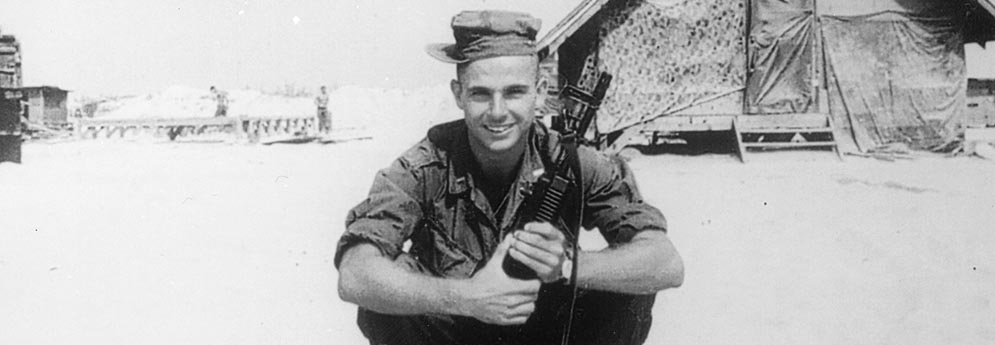By Lt. Colonel J.W. Gibbs III, U.S. Marine Corps, (Retired)
In the late Winter of 1967 Lima Company, Third Battalion, First Marine Regiment, First Marine Division was engaged in combat against Viet Cong, Main Force, and North Vietnam Army units south of DaNang, South Vietnam with a primary mission of destroying the enemy or his will to fight. By the end of February this Marine rifle company also had a secondary mission: to combat test the Stoner 63A Weapons System to determine its suitability for the Marine Corps. The company of Marines exchanged their .45 caliber pistols and 7.62 mm NATO rifles and machineguns for new, heretofore untried rifles, carbines, and machine guns firing a modified .22 caliber round. They were expected to unquestionably accept these toy-like weapons with tin-can plinking ammo to perform equally or better than those tried and true weapons they had relinquished. Without complaint they educated and prepared themselves to return to anti-guerrilla warfare bearing the weapons of the Stoner system. No one expected the Stoners and its smaller sized ammunition would perform any differently than the tough, reliable former weapons or the Marines who carried them. I know these facts because I was the company commander.
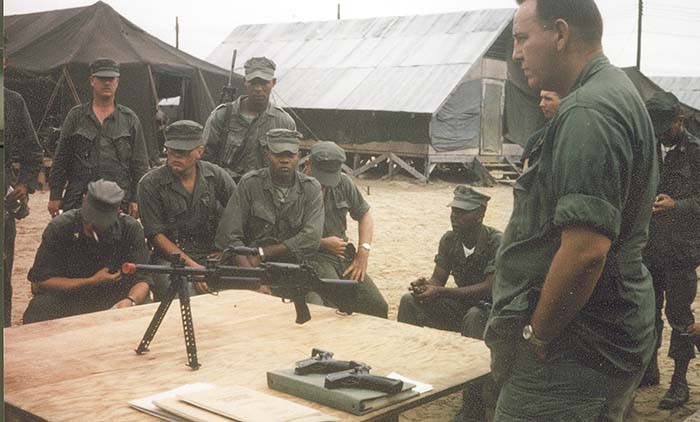
In 1951 Brigadier General S.L.A. Marshall, U.S. Army, wrote about the relationship between small arms weapons and the men who used them during the Korean winter campaigns of 1950-51. General Marshall wrote of two prominent observations concerning weapon usage: 1. Troops in combat are reluctant to use something new unless a reliable, respected source tells them it’s better than to what they are accustomed, and 2. Nothing reinforces acceptance better than personal experience.1 Sixteen years later Lima Company demonstrated that something as personal as exchanging one’s tried and true individual weapon in combat for a new, untried, and failing weapon could still be overcome and championed.
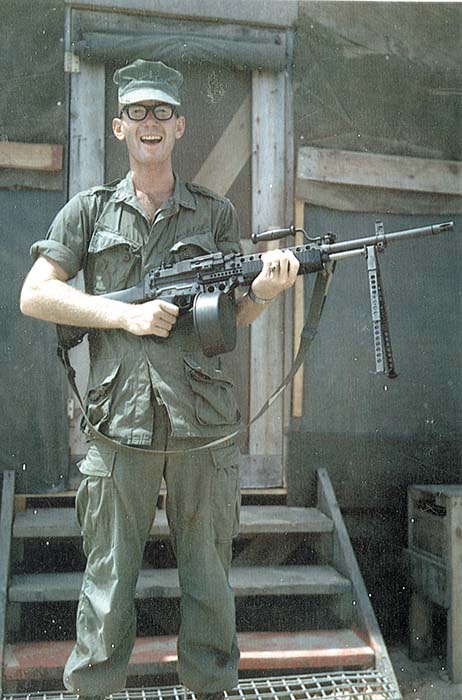
Lima Company was a no nonsense unit in the U.S. Marine tradition. We were aggressive, disciplined combat Marines with keen skills in tactics and fighting honed in combat. We were not an infantry school’s demonstration troops performing a rehearsed skit in front of a military-industry group of suits. The Marines were the same Marines they were before the arrival of the Stoners and its 5.56 ammunition. We thought of our small arms not as a weapon plus a bullet but as one component. Our expectation was that a round in the chamber of a weapon should respond to the strike of the firing pin by firing, always. The weapon and ammo were one. Thoroughly clean weapons were a given fact of unit survival. Equally accepted was the understanding that weapons in combat endure the ruggedness of battle as well as the Marine firing it. Both Marines and weapons get dirty, wet, slogged, beaten and maligned, and they will be cherished and loved. The dependable M14 Rifle, M60 Machinegun, and M1911A1 Pistol when so disposed still worked, and they would be our standard of comparison.
The relationship between a Marine and his weapon is ingrained in him starting at the recruit depots. His education manifests a subconscious belief in his issued weapon. In combat, acceptance changes from potential dependency to pragmatic affection. The popular press notion that combat Marines treat weapons with indifference and clean them occasionally and without concern for future dependability is ludicrous, but it is an impression left by repeated proclamation. Once one shoots his weapon at an armed enemy the bond is made. If the weapon works for him, the bond will grow stronger. The opposite is also just as true. To change the latter, Marine leadership emanating from known and respected sources will be the change agents, not written hype or a command from a multi-starred general, and certainly not from a political appointee or an elected official.
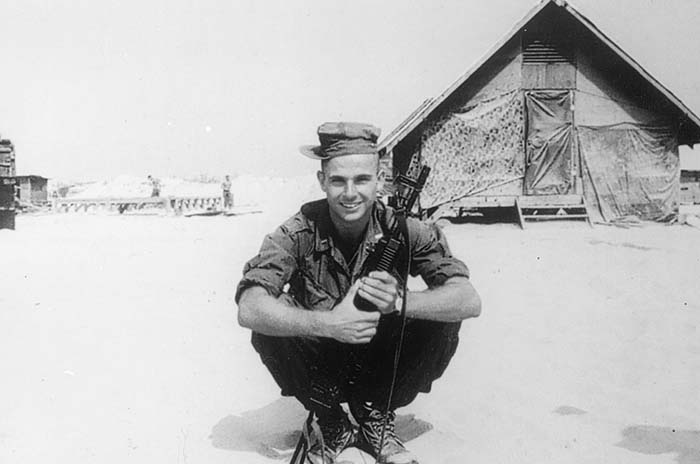
We would test five Stoner configurations: assault rifle, carbine, two light machinegun (LMG) types (magazine fed and the belt/box fed), and the medium machinegun (MMG). Officers and Staff Non-commissioned Officers (SNCO’s) were issued carbines. The rifles went to all Marines who previously were armed with M14 rifles, except some would be armed with the LMG magazine fed. The machinegun section of Weapons Platoon, consisting of three machinegun squads with two guns each, were armed with a mix of LMG and MMG.
In our test period the name Light Machine Gun, Magazine Fed and the Automatic Rifle referred to the same weapon type: the top loading magazine fed weapon. In the days leading up to Lima Company’s training in the Stoner system, we were to request the type and amount of weapons desired using our existing Table of Equipment as a guide. Of course that equipment was based upon the former weapons and not on a Stoner family of weapons, but it did provide a point of departure. Lima Company had nine rifle squads each with three fire teams, and each fire team consisted of four men with one of them armed with an M14 with a selector switch on automatic. There were twenty-seven fire teams in the company, and, therefore, twenty-seven M14’s configured to automatic. I ordered twenty-seven LMG’s, Magazine Fed to replace the twenty-seven automatic M14’s. However, one day prior to the commencement of training we were informed that the LMG, Magazine Fed/ Automatic Rifle would not be tested as it had been already determined to be reliable. In correspondence, that weapon was referred to then as the “Automatic Rifle.” Nevertheless and regardless of whatever name was in vogue, we did receive and fielded at least seven top loading magazine fed machine guns/automatic rifles. After about five weeks of combat usage we determined that this configuration was not necessary. Every Stoner weapon was easily capable of being an automatic weapon although we still held to the doctrine of one Stoner on automatic with three on semi-automatic per fire team. On April 4, 1967 those “Automatic Rifles” were turned in as superfluous.
As users of the weapons we were less interested in the engineering and revolutionary aspects of the hardware. Our concern was would it work – shoot fast and straight. We had a combat mission to perform, and the weapons were our basic tools. We needed to learn and learn quickly the particulars of these weapons: assembly, disassembly, maintenance, and functioning. Then we needed to “feel” the capability of these weapons, gain confidence in their reliability, and transfer our loyalty from something tried and true to something unknown and potentially untrue.
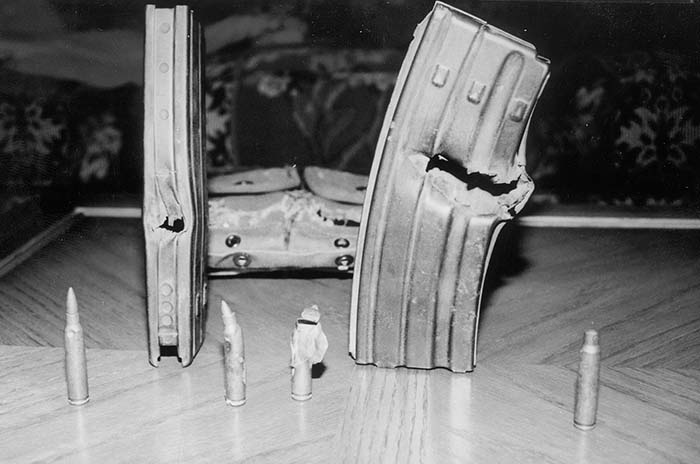
The Stoners were shown and demonstrated to the Marines. Within moments of first seeing and touching the weapons, the generalized apprehension melted away. These weapons, these Stoners, were immediately impressive. They were absolutely radical in design, function, and appearance to anything any of us had ever seen. There was something in their appearance alone that broke down skepticism; a sort of enchantment overcame us and brought on an air of excitement. “I want to fire that baby!” might be an apt exclamation. The absence of wood was most noticeable, followed by the perforated metal, the plastic, the pistol grip, the lightness, and the balance upon picking them up. Obviously, here for us now was something from the future.
Lima Company was to conduct a sixty-day trial of five of the Stoner family members. Eugene Stoner, for whom the weapons were named, designed a system that permitted reconfiguration of rifles and rifles into machineguns. The brilliant, self-taught engineer and designer while at ArmaLite designed most notably the AR10 and AR15 later designated the M16 rifle. In 1961 Mr. Stoner took his art to Cadillac Gage where he designed a family of weapons based on two major revolutionary concepts. These concepts became reality when Mr. Stoner produced his 62 system encompassing ease of interchangeability of parts between a weapon to make another weapon and a new gas operating system. One of the basis for these changes was in the receiver. With the receiver placed with the magazine well down, the weapon was a rifle or carbine capable of firing semi or full automatic. By turning the receiver upside down so that the magazine well was on top, the weapon became a machinegun. There were other steps and pieces of course. Nevertheless, the gas system required to operate a rate of fire from 660 to 750 rounds per minute coupled with the interchangeability of parts represented the heart of the Stoner 63A “family” concept of weapons.
A Marine training team from Marine Corps Base, Quantico, Virginia conducted eighteen hours of formal classes in the austere, outdoor conditions of the battalion’s combat base and squad leaders conducted an additional six hours with their squads. Each Marine fired his weapon on a known distance range inside the battalion perimeter. The number of rounds fired was based upon the type of weapon and until the Marine was satisfied with the operation of his particular weapon. We had an adequate but limited supply of 5.56 Ball ammo. The minimum rounds fired per weapon per Marine was, carbines and rifles 250 rounds, automatic rifles fired 270, and both the light and medium machineguns fired 1000.4 Training went well. We were mentally and physically prepared to take the Stoners into combat. On 28 February 1967 Lima Company, now armed with the Stoner 63A weapons system, departed the battalion area and resumed combat patrols. The Stoner went to war.
The enemy quickly became aware of us and our new weapons due to the peculiar sound that 5.56 ammo made compared to the 7.62 that every other Marine rifle company in our area was using. The 5.56 had a high pitched buzzing sound. We were the only unit for many miles around that fired the 5.56 ammo. (The First Marine Division was in the process of changing from the M14 to the M16, but our battalion was scheduled to receive the M16 in April.
One of our patrols found an old house that served as a Viet Cong classroom, for on the wall was a detailed, accurate drawing of a Stoner rifle. Enemy activity was far from passive though. On 3 March Corporal Bill Pio’s second squad, second platoon, with Lance Corporal Dave Mains as radio operator, sighted enemy. The squad was on a daylight combat patrol when the point man, Lance Corporal Kevin Diamond, spotted several VC under a tree out to their front. The squad halted and Pio and Mains cautiously crawled up to Diamond’s position. Corporal Pio figured his plan, and as he started to deploy the squad, they were taken under fire. Both Pio and Diamond were seriously wounded while the squad opened up on a disappearing enemy. Following the medical evacuation of the two wounded Marines, someone noticed Mains’ equipment hanging off his cartridge belt under the radio. One of his canteens and two Stoner magazines were shot. The Stoner steel magazines loaded with bullets and the water filled canteen had deflected further penetration of the bullets preventing Lance Corporal Mains from wounds. He did retain and took home the bullet shattered steel magazines and canteen.
Our instructions relating to the conduct of the Stoner test included experimentation to include how the company’s organizational structure might adapt to the Stoner family of weapons and innovations by individual Marines. One such innovation came from the second platoon commander, Second Lieutenant William Wischmeyer. Prior to the Stoner tests, officers and SNCO’s carried pistols for self-defense. One primary reason for arming leaders with pistols is to keep them from becoming too involved in shooting so that they concentrate on directing Marines and their fire. Leaders are continuously involved in reading maps, directing artillery fire, radio communications, and generally shouting orders, waving arms, and pointing to direct movement. The carbine was carried in one’s hands instead of a holster making hand and arm signals difficult and automatically made leaders “quasi-rifleman.”
Lieutenant Wischmeyer quickly recognized the problem in command and control and took initiative to resolve it. He took several pieces of web gear, a blanket roll strap and a belt suspender with its spring clip, and made a sling that hooked onto the top of the wire stock carbines. The company executive officer, First Lieutenant Gran Moulder, remembered Lt. Wischmeyer was the butt of wise-cracks regarding this field improvisation called the “Wischmeyer sling.” The jokes did not last long as the utility of the sling quickly was recognized and adopted by every carbine-carrying member of the company. The jokes stopped and the Wischmeyer sling came to be called the jungle sling.
The jungle sling was criticized by a general officer for its unpolished appearance and a hindrance to sighting. The jungle sling permitted leaders the full use of their hands and arms which they needed more than to aim in and shoot a round or two. The Stoner Carbine was a finely balanced piece, and I carried mine using the jungle sling. The adjustable sling placed the pistol grip about waist level with the butt of the pistol grip facing rear, and permitted freedom of the hands. On occasion I would quickly drop my right hand down to the pistol grip while pushing down and forward bringing the muzzle smoothly to the horizon where my left hand would meet the front hand-guard as I leaned forward. The ammunition followed my right hand movement as if firing from my finger. The rounds just seemed to go where I willed them. It was the most amazing experience. The sling was a necessity. I disregarded the criticism. We kept using the Wischmeyer sling throughout the test period even after its designer was wounded and evacuated on 8 March. Lt. Wischmeyer’s nine-day contribution to the Stoner trial was significant.
After twelve days of patrolling, we returned to the battalion area where we replenished equipment, rested, and prepared for our next outing. We were required to maintain four reports, which we completed and analyzed inside the battalion compound. One of the reports was a “Malfunction Report.” I did not expect this report to be used very often. But it was. The Marines reported thirty-three malfunctions had occurred during this initial twelve days occurring across all five-weapon configurations. The most common were failures to feed, failures to fire, failures to eject, and failures to extract. Failure to fire struck me as most distressing. Primer caps were dented by firing pins and yet the rounds did not fire. Causes? Corrective action? Why were these malfunctions happening? Answers were not clear, but, all in all, the problems meant my Marines were not able to defend themselves. Frankly, this malfunction was difficult for me to accept. Despite these written reports, the Marines’ reaction to the Stoner remained favorable. Shortly thereafter, we returned to the field.
On March 15, the First Platoon Commander, Lt. Andres Vaart, sent out an ambush patrol just before the end of evening light. The patrol was armed with one M79 Grenade Launcher, two Stoner LMG’s, and two Stoner assault rifles set on automatic. As the patrol moved to its ambush site, it met a VC patrol moving towards the company’s patrol base and took them under fire. Of the four Stoner weapons in the patrol, only one rifle worked without malfunctioning, the other three experienced a multitude of problems. The one operating rifle, the M79, and hand grenades were used to drive off the well-armed VC patrol whose weapons were working well. Simultaneously, the company patrol base came under attack. This company action also revealed more malfunctioning weapons.
The Marines of Company L were now clearly saddled with a weapon that could not be counted on. My Marines seemingly could not depend on their individual weapons either to defend themselves or employ them in aggressive action. The malfunction problems needed resolution before any more patrols were activated. Under the present circumstances instead of looking for the enemy we were forced to concentrate on making the weapon work. I cancelled all further patrols that night and gathered all three platoons into one company perimeter. The Company Gunnery Sergeant, Gunnery Sergeant Bill McClain, cleared a space and designated it a firing line. Rotating one squad at a time we fired throughout the night checking each weapon and recording malfunctions taking remedial action where necessary and possible. Regardless of what we tried, no field remedy consistently resolved the problems. The same malfunctions found in the first twelve days were again the most common. I had to accept that our new weapons were not dependable. At first light, Lima Company maneuvered back to the battalion compound.
These Stoners were our weapons, and we had to make them work. We needed to resolve the problem ourselves. We knew more about the Stoners than anyone available did. We “Turned-To.” We reasoned that the primary causes of malfunctions included sand, lubrication, moisture, and ammunition. There was no way we could avoid sand and we definitely needed the ammunition. The problem to solve then became how does sand, moisture, and lubrication contribute to malfunctions and how to get rounds to fire. For better than two days inside the security of the battalion’s sand berm walls, we conducted our own methodical sub-trials.
The area we operated in was part of the South China Sea’s coastal plains. The sand was not course sand but very fine sand. We occasionally rode amphibious tractors that pulverized the sand with its tracks that turned fine sand to a talcum powder like consistency and lifted up and over the tops of the vehicles where we rode settling in on everything. In short order we were covered with white dust which would sift into every pore it could find on both weapons and men. We tried protecting our Stoner’s by wrapping them in green towels. Further, our everyday activities took us into the sand. We walked, ate, slept, and fought in this fine sand. Next to air it was the most prevalent natural element.
Another suggested condition, which came under immediate scrutiny, was noted three weeks earlier during familiarization firing. The moving parts in every configuration appeared to be too tightly machined. As we saw it and what we could address, the crux of the problem became tightly machined parts coupled with oiled sand affixed thereto created excessive friction.
Our basic answer was to shoot, shoot, shoot. Loosen them up. Each Marine shot hundreds of rounds through his personal weapon under the scrutiny of the platoon sergeants and squad leaders with the Company Gunnery Sergeant and First Sergeant George Bean’s watchful supervision. Every malfunction brought about a “Cease Fire” to the line while the malfunction was “eyeballed,” recorded, and cleared. It was a slow but necessary process. We began to make progress. Not only did the weapon malfunctions need to disappear, but also the confidence of each Marine had to soar. We looked for and found another Lot of ammunition.
On 18 and 19 March Lt. Michael Kelly’s5 Third Platoon rehearsed an attack plan scheduled for the near future while concurrently assessing the progress in our malfunction sub-trial. Each weapon (Assault Rifle, LMG. MMG, Automatic Rifle, and Carbine) was thoroughly cleaned and oiled in accordance with what each individual Marine knew about his weapon as a result of the firing tests. Then they crawled through the sand to a firing line and commenced firing 100 rounds each. Following this firing, they climbed aboard amphibious tractors, took a three mile ride across the sands, returning covered with fine talcum powder sand, disembarked, and scrambled back to the firing line where they commenced shooting another 100 rounds. When a malfunction occurred each individual needed to remedy it using his own knowledge.
Our concentration on the combination of sand, oil, and tolerances as the cause of malfunctions was paying dividends at this field-user level. Other things were also noted, but we could do little about those except to report and comment on what we thought might be occurring and what might be a solution. The ammo problem was greatly reduced following receipt of a new Lot of ammo. I was confident that we had loosened the moving parts and learned enough that the weapons were now dependable provided each Marine practiced his knowledge of his individual weapon. I trusted my Marines to act with wisdom. We returned to combat that night.
Our next ten days were markedly better. As usual we ran into the normal plethora of mines and booby traps along with our very successful ambush and combat patrols. We also captured two VC. Lima Company was back aggressively accomplishing its primary mission. Further, the concerns about Stoner reliability decreased significantly. By 3 April we reported that the weapons were “working very well.” I requested that the test period of sixty days be extended to ninety for a better trial. The request was approved.
During this ninety-day Stoner combat weapons’ trial both the Marines and the 63A’s were challenged. In addition to our daily combat patrolling, the company participated in four named battalion or larger combat operations between 28 February and 31 May, 1967. The 63A’s became less a test weapon and more our personal weapon changing from questionable reliability to pragmatic affection. Combat plans were made and executed without concern for weapon reliability, as it should be.
Combat is not a game, and any individual infantry Marine needs to “pounce and shoot” without a second of delay. In those first few weeks our Stoners barely made the grade. The discipline and mettle of some one hundred eighty Marines met the challenge head on and won. They led with their jaws, took a couple of hits, saw the problem, and made the weapons work for them. They experimented, innovated, and sought empirical proof. Were the malfunctions that Lima Company encountered due to the weapon or were they the result of factors outside the design and engineering? By the end of the first month we knew that the problems encountered earlier were not the fault of either design or engineering.
While engaged in daily combat, Lima Marines learned to respect, admire, and covet the Stoner 63A in all five configurations. For the third time in three months, in late May 1967 we again exchanged one personal weapon for another. This time, the Stoner for the M16A1, which already had earned an horrific reputation. Our Stoner experiences quickly transferred to the unreliable M16. Nevertheless, the Stoner had replaced the M14 as our standard, and the M16 never reached the Stoner bar.
Lieutenant Colonel Gibbs is writing a book on the Stoner 63A Weapons System, and would enjoy hearing from readers. Please send your comments to him via Small Arms Review, Attention: J. Gibbs.
- 1 S.L.A. Marshall, Infantry Operations & Weapons Usage in Korea, with a Preface by Edward C. Ezell, Greenhill Books, Lionel Leventhal Limited, Park House, 1 Russell Gardens, London, NW11 9NN, p. xiv, 14 and 54.
- 2 Commanding Officer, Company L, Third Battalion, First Marines, First Marine Division (Reinf), FMF, FPO, San Francisco, 96602 memorandum of 3 and 4 April 1967. (Short title: CO, L/3/1 plus date)
- 3 A very good overview of the workings of the Stoner weapons is described in Dan Shea’s article: Dan Shea, “The Stoner Chronicles, Part IV: The Crown Jewel,” Machine Gun News, May 1996, pp 41 and 42.
- 4 CO, L/3/1, 13 March 1967 memorandum “Stoner Report.”
- 5 The author is proud to note that both lieutenants Kelly and Wischmeyer were lieutenant colonels in the 1980’s and commanded the Third Battalion, First Marine Regiment.
| This article first appeared in Small Arms Review V5N7 (April 2002) |



